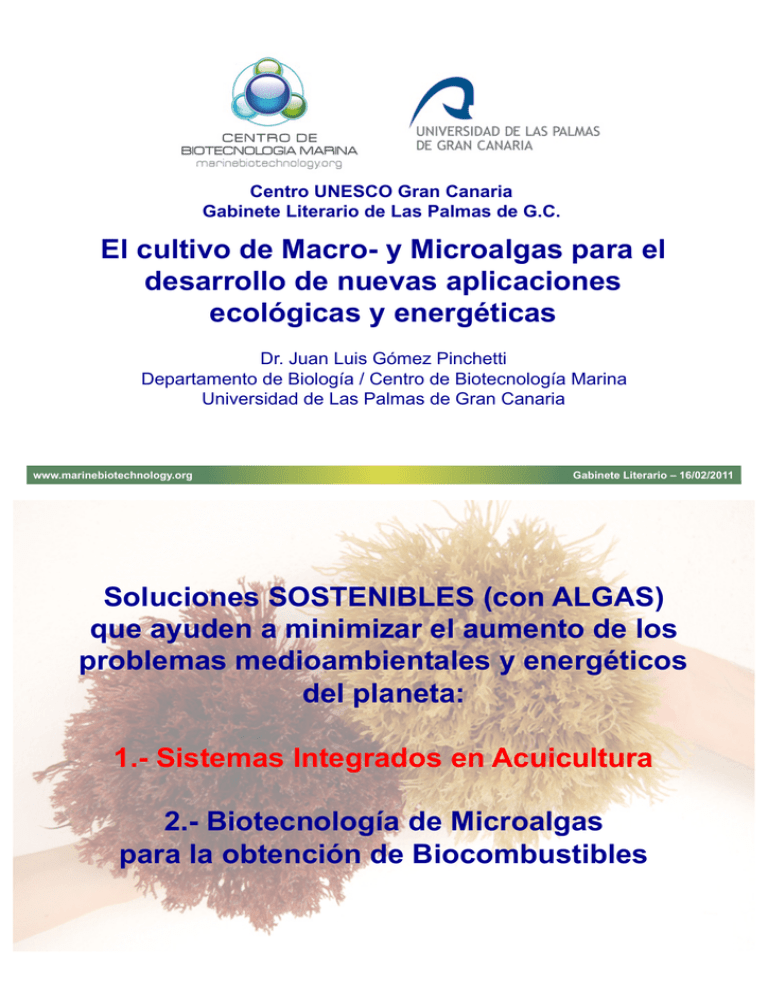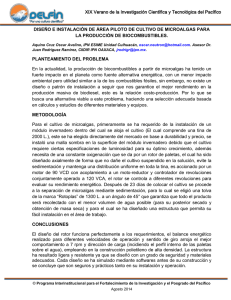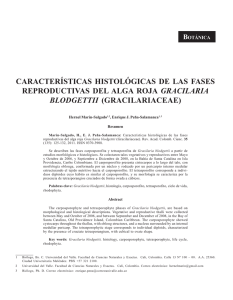0622044_00000_0000.pdf
Anuncio

Centro UNESCO Gran Canaria Gabinete Literario de Las Palmas de G.C. El cultivo de Macro- y Microalgas para el desarrollo de nuevas aplicaciones ecológicas y energéticas Dr. Juan Luis Gómez Pinchetti Departamento de Biología / Centro de Biotecnología Marina Universidad de Las Palmas de Gran Canaria www.marinebiotechnology.org Gabinete Literario – 16/02/2011 Soluciones SOSTENIBLES (con ALGAS) que ayuden a minimizar el aumento de los problemas medioambientales y energéticos del planeta: 1.- Sistemas Integrados en Acuicultura 2.- Biotecnología de Microalgas para la obtención de Biocombustibles Procesos metabólicos relacionados con el cultivo de peces Air (oxigen) Feed Not ingested NH3 Oxidation Metabolism Bacteria Phytoplankton Feces NO2- Waste production: - NH4+ (>> NO3- - NO2-): (DIN) - Dissolved compounds (P-PO4) - Particles (solid elements - TSS) - CO2 (Repiration) Solid Sediments Hussenot (2003), Aquaculture 226:113-128 Waste Oxidation Aerobic Bacteria NH4+ >> NO3- >> NO2Anaerobic Bacteria NO3- >> N2 NO3- Qingdao Bay (China) Loya et al. (2003) MEPS 261:299 Eilat (Israel) Acuicultura Multi-Trófica Integrada (IMTA) Sistemas de Policultivo Integrado Flujo de agua Nivel Trófico superior Niveles Tróficos inferiores Acuicultura Multi-Trófica Integrada (IMTA) Principios básicos: (1) Conversión en lugar de dilución (ecológico) (2) Diversificación de especies (cultivo y producción de nuevas especies) (3) Aumento de los Ingresos (económico) Biofiltración con macroalgas: concepto 1790 kg feed 132 kg N (100%) 25 kg P (100%) Fish retained 28.5 kg N (22%) 7.2 kg P (29%) Excretions 80.5 kg N (61%) 4.8 kg P (19%) Soluble feces 9.2 kg N (7%) 2.0 kg P (8%) Particulates feces 13.2 kg N (10%) 11.0 kg P (44%) Nutrients balance from a seabream cultivation unit in kg Tm-1 produced to 400 g (relative percentages expressed as a function of feed input) Feed N= 187.9 (92.1%) P= 24.8 (91.5%) C= 1099.8 (92.2%) Biomass - adults N= 54.4 (26.7%) P= 6.5 (24.0%) C= 308.8 (25.9%) Salmon Sedimentation Gracilaria Water output N= 31.5 (15.4%) P= 12.5 (46.1%) C= 404.3 (34.0%) Solid Wastes N= 66.5 (32.6%) P= 8.0 (29.5%) C= 436.8 (36.6%) Dissolved assimilated N= 51.7 (25.3%) P= 0.1 (0.4%) C= 42.3 (3.5%) Nutrients balance (%) Production period: 13 months Intensive: 1.6 Tm salmon + Gracilaria (Buschmann et al., 1996) Microalgas (HRAP) SW Recirculación (-NH4+; +O2) Sedimentación / Saprófagos SW input SW output Peces o quizás! Filtradores Macroalgas Esquema de un sistema indicando los flujos de agua entre compartimentos ¡ Halófitas o Manglares ! Metri - Chile AWI - Germany Neori et al. (2007) Environment T 50 + RW 130 m2 N SW FP FP Gran Canaria Island V DP GH2 – HL (80%) RW WSW GH1 – LL (20%) SCT CPT CPT SCT SCT CPT SCT: 1.8 m2 – 750 L CPT: 1.5 m2 – 1500 L RWS: 8 m2 (3x) RWM: 30 m2 (2x) RWB: 50 m2 (1x) Growth performance of seaweed species with potential commercial significance in integrated poly-aquaculture systems Gracilaria cornea G. cornea var. green G. verrucosa G. gracilis G. bursa-pastoris Hypnea spinella H. musciformis Halopytis incurva Grateloupia dichotoma G. doryphora Laurencia chondrioides Asparagopsis taxiformis Drachiella minuta Corallina elongata Codium taylorii Valonia utricularis Ulva rigida BIOFILTRACIÓN DE EFLUENTES DE PISCIFACTORÍAS CON ALGAS Y USO DE LA BIOMASA: SUSTANCIAS DE INTERÉS AGRONÓMICO, PISCÍCOLA Y BIOMÉDICO-FARMACOLÓGICO PISCIFACTORÍA Efluentes ricos en nutrientes MACROALGAS BIOFILTRADORAS Efluente depurado BIOMASA DE ALGAS USO AGRONÓMICO Bioestimuladores Compost Proyecto DEPUSIAL AGL2001-1888-C03 Proyecto SEAPURA QLRT-1999-31334 Ulva rigida UMA (MICROBIOLOGÍA) USO PISCÍCOLA Inmunoestimuladores Alimento UMA (FOTOBIOLOGÍA) USO BIOMÉDICOFARMACOLÓGICO Fotoprotectores Antioxidantes Inmunoestimuladores Con N/P Sin N/P (+ Ci) Halopithys incurva Sin N/P (+ Ci) Con N/P Per every 100 kg of N and P consumed (7.3% N and 0.9% P): Sea bream yields: 64.59 kg N dissolved 14.85 kg N particulated 22.96 kg P dissolved 47.24 kg P particulated Sea bass yields: 60.90 kg N dissolved 19.80 kg N particulated 19.56 kg P dissolved 47.64 kg P particulated Nova Scotia (Canada): Laminaria Maine (USA): Porphyra Chile: Macrocystis Vergara et al. (2005) N and P production per Tm produced of sea bream and sea bass in pens (in The Canary Islands): 120.0 kg N (78.4% soluble) 16.8 kg P (69.1% particulated) AWI Bremerhaven (Germany): Laminaria See the Integrated Aquaculture video at www.aquanet.ca Soluciones SOSTENIBLES (con ALGAS) que ayuden a minimizar el aumento de los problemas medioambientales y energéticos del planeta: 1.- Sistemas Integrados en Acuicultura 2.- Biotecnología de Microalgas para la obtención de Biocombustibles OCEANIC FARMS for energy production (methane, ethanol,!) And recently ! CO2 absorption Energy production Wilcox and Sunrise Projects Methane (biogas) Hydrocarbons Ethanol Filtración de CO2 por cultivo intensivo de microalgas (FBR) 1 Tm biomasa algal: • fija 450 Kg CO2 • produce 1.200 Kg O2 Algología Planetaria ! Spirulina o Chlorella en el espacio: ! Para transportar / generar O2 ! Para filtrar / eliminar CO2 ! Para eliminar/ regenerar residuos ! Para transportar/ generar calorías ! Para transportar/ gener. nutrientes Brennan & Owende. 2010. Renewable and Sustainable Energy Reviews 14:557–577 Sheehan (2009) Current Opinion in Biotechnology, 20:318–324 Beer et al. 2009. Current Opinion in Biotechnology, 20:264–271 Selección de especies (cepas) 䚉 Consideraciones importantes: • Composición: lípidos (tinción Rojo de Nilo), carbohidratos, proteínas • Carácterísticas de crecimiento: altas producciones • Posibilidades de cultivo a escala industrial • Estadíos para la síntesis de metabolitos (una/dos fases; condiciones de estrés) • Rendimientos: biomasa producida * concentración del “producto de interés” • Disponibilidad: Colecciones de cultivo • Mejora de especies: por selección o ingeniería genética Benneman (2009) NATIONAL BANK OF ALGAE Culture Collection Altra – Flow cytometer with cell sorting Dunaliella Flow cam Ho et al., Biotechnol. Adv. (2011) Cultivo: crecimiento, eficiencia fotosintética y producción www.solixbiofuels.com www.seambiotic.com Aplicaciones medioambientales (CO2 y aguas residuales) Greenhouse Gas Mitigation Project (Int. Univ. Bremen) www.irccm.de Micro-photobioreactors at the E.ON power plant ! Tratamientos de aguas residuales: ! Biofiltración de nutrientes inorgánicos de la Acuicultura ! Aguas residuales de actividades Agrícolas (p.e. purines) ! Aguas residuales Urbanas ! Aguas residuales de los procesos de producción de Biogas Bio-Hydrogen Schenk et al. 2008. Bioenergy Research • Hydrogenase (eukariotic algae): Chlamydomonas, Scenedesmus – light and anaerobic cond., or • Nitrogenase (in Cyanobacteria): catalyze H2 (gas) production in the absence of O2 y N2 Bio-Methane and Bio-Ethanol A Review of the Potential of Marine Algae as a Source of Biofuel in Ireland (2009) www.algenolbiofuels.com Biodiesel Botryococcus Neochloris Singh & Gu. 2010. Renewable and Sustainable Energy Reviews (in press) FA Fatty Acid Alcohol Glycerin FA FA FA Biodiesel Vegetable Oil solixbiofuels Chisti, Y. (2007). Biotechnol. Adv. 25:294 MICROALGAL CULTIVATION FOR CO2 BIOFILTRATION AND BIODIESEL PRODUCTION ¿ Bio-combustibles CO2-neutros ? Scott et al. Current Opinion in Biotechnology 2010, 21:1–10 Biorefinery Concept Tendencias y Desafíos Dr. S. Mayfield The ideal photosynthetic cell factory for production of biofuels R. H. Wijffels et al., Science 329, 796-799 (2010) Published by AAAS www.solix.com ¡ Sueño o Realidad ! www.sapphireenergy.com Algae-filled Hummer Muchas Gracias por su atención Iwamoto-Scott Architecture www.iwamotoscott.com

